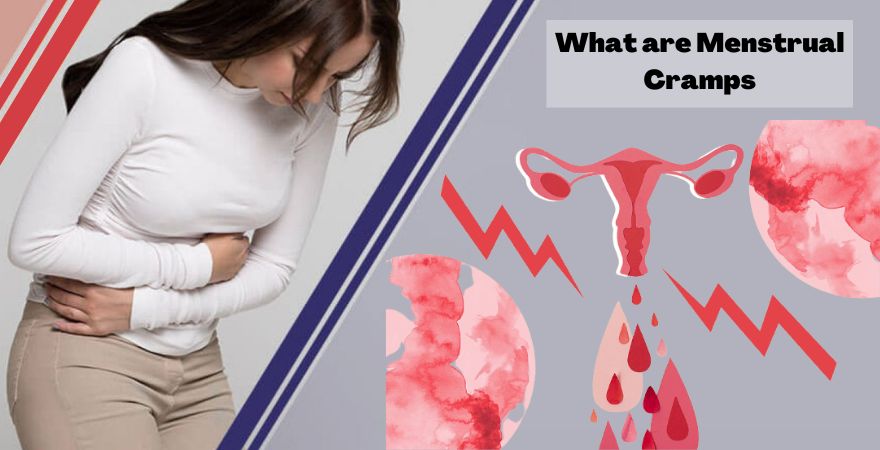Menstrual cramps, also known as dysmenorrhea, are painful cramps that some people experience during their menstrual cycle. Menstrual cramps can vary in intensity, ranging from mild discomfort to severe pain that can interfere with daily activities. Dysmenorrhea is caused by the contraction of the uterus as it sheds its lining during menstruation.
The uterus contracts to help expel the blood and tissue from the body. Hormone-like substances called prostaglandins, which are produced in the lining of the uterus, can increase the intensity of these contractions and contribute to dysmenorrhea.
In addition to cramping, some people may also experience other symptoms during their menstrual cycle, including bloating, headaches, fatigue, and mood changes.
While cramps can be uncomfortable, there are several over-the-counter remedies, such as pain relievers and heat therapy, that can help alleviate the pain. If cramps are severe or interfere with daily activities, it may be helpful to speak with a healthcare provider to explore other treatment options.
Causes of Menstrual Cramps
Menstrual cramps, also known as dysmenorrhea, are caused by the contraction of the uterus as it sheds its lining during menstruation. The uterus contracts to help expel the blood and tissue from the body. Hormone-like substances called prostaglandins, which are produced in the lining of the uterus, can increase the intensity of these contractions and contribute to dysmenorrhea.
Read more – Important Reasons, Causes of Cramping in Periods :
In addition to prostaglandins, other factors can contribute to menstrual cramps, including:
- Endometriosis: This is a condition in which tissue similar to the lining of the uterus grows outside of the uterus, causing pain and discomfort.
- Adenomyosis: This is a condition in which the lining of the uterus grows into the muscular wall of the uterus, causing pain and discomfort.
- Uterine fibroids: These are noncancerous growths in the uterus that can cause pain and discomfort.
- Pelvic inflammatory disease (PID): This is an infection of the female reproductive organs that can cause pain and discomfort.
- Ovarian cysts: These are fluid-filled sacs that can form on the ovaries, causing pain and discomfort.
- Cervical stenosis: This is a condition in which the opening of the cervix is narrow, which can cause menstrual blood to back up into the uterus and cause pain and discomfort.
- Psychological stress: Stress can cause muscle tension, which can exacerbate cramps.
Menstrual cramps are a normal part of the menstrual cycle for many people and can be managed with over-the-counter pain relievers, heat therapy, and other self-care measures. However, if dysmenorrhea is severe or interferes with daily activities, it is important to speak with a healthcare provider to explore other treatment options.
Symptoms
The main symptom of menstrual cramps is pain in the lower abdomen, which can range from mild to severe. The pain may be a dull ache or a sharp, stabbing sensation, and may radiate to the lower back or thighs. Other symptoms of cramps can include:
- Nausea and vomiting
- Diarrhoea
- Constipation
- Bloating or water retention
- Headaches or dizziness
- Fatigue
- Mood changes, such as irritability or depression
The severity of cramps can vary from person to person, and can also vary from one menstrual cycle to the next. dysmenorrhea typically occurs a few days before the start of menstruation and can last for several days. If cramps are severe or interfere with daily activities, it is important to speak with a healthcare provider to explore other treatment options.
Treatment of Menstrual Cramps
The treatment of menstrual cramps, or dysmenorrhea, can vary depending on the cause and severity of the pain. Here are some common treatment options:
- Over-the-counter pain relievers: Nonsteroidal anti-inflammatory drugs (NSAIDs), such as ibuprofen and naproxen, can help reduce dysmenorrhea by blocking the production of prostaglandins.
- Hormonal contraceptives: Birth control pills, patches, or vaginal rings can help reduce cramps by regulating hormonal fluctuations.
- Heat therapy: Applying heat to the lower abdomen can help relax the muscles of the uterus and reduce cramps. You can use a heating pad, a hot water bottle, or take a warm bath.
- Exercise: Gentle exercise, such as walking or stretching, can help reduce dysmenorrhea by increasing blood flow and releasing endorphins, which are natural painkillers.
- Dietary changes: Avoiding caffeine and alcohol, and increasing your intake of fruits and vegetables, can help reduce inflammation and reduce cramps.
- Relaxation techniques: Practicing relaxation techniques, such as deep breathing or meditation, can help reduce stress and anxiety, which can contribute to dysmenorrhea.
- OTC supplements: Some over-the-counter supplements, such as magnesium, vitamin B1, and omega-3 fatty acids, may help reduce cramps.
If menstrual cramps are severe or interfere with daily activities, it is important to speak with a healthcare provider to explore other treatment options, such as prescription pain relievers or surgical options. Additionally, if dysmenorrhea is caused by an underlying condition, such as endometriosis or uterine fibroids, treating the underlying condition may be necessary to manage the pain.
Home remedies for cramps
- Herbal teas: Drinking herbal teas, such as ginger, chamomile, or peppermint tea, can help reduce cramps.
- Essential oils: Some essential oils, such as lavender, clary sage, and marjoram, may help reduce cramps when applied topically or used in aromatherapy.
- Acupressure: Applying pressure to certain points on the body, such as the webbing between the thumb and index finger, may help reduce cramps.
Detailed Read More – Home remedies for cramps in Periods
It is important to note that while these home remedies may provide relief for some people, they may not be effective for everyone. If cramps are severe or interfere with daily activities, it is important to speak with a healthcare provider to explore other treatment options. Additionally, if cramps are caused by an underlying condition, such as endometriosis or uterine fibroids, treating the underlying condition may be necessary to manage the pain.
Diet can help with Menstrual Cramps
There is some evidence to suggest that dietary changes may help alleviate dysmenorrhea, by reducing inflammation and promoting hormonal balance. Here are some dietary recommendations that may be helpful:
- Eat a balanced diet: Eating a balanced diet that is rich in fruits, vegetables, whole grains, and lean protein can help reduce inflammation and promote overall health.
- Increase your intake of omega-3 fatty acids: Omega-3 fatty acids, which are found in fatty fish, nuts, and seeds, may help reduce inflammation and alleviate dysmenorrhea.
- Avoid caffeine and alcohol: Caffeine and alcohol can cause dehydration and may worsen menstrual cramps.
- Reduce your intake of salt: Salt can cause water retention and bloating, which may exacerbate dysmenorrhea.
- Get enough magnesium: Magnesium may help reduce cramps by relaxing the muscles of the uterus. Foods that are rich in magnesium include dark leafy greens, nuts, seeds, and whole grains.
- Consider herbal supplements: Some herbal supplements, such as ginger, turmeric, and cinnamon, may help reduce inflammation and alleviate dysmenorrhea.
It is important to note that dietary changes may not work for everyone, and it is always a good idea to speak with a healthcare provider before making significant changes to your diet. Additionally, if dysmenorrhea is severe or interferes with daily activities, it is important to speak with a healthcare provider to explore other treatment options.
Conclusion
Menstrual cramps are a common experience for many people who menstruate and can range from mild discomfort to severe pain. There are several treatment options available, including over-the-counter pain relievers, hormonal contraceptives, heat therapy, exercise, and dietary changes.
Home remedies such as applying heat, exercising, and making dietary changes may also be helpful in relieving dysmenorrhea. However, if cramps are severe or interfere with daily activities, it is important to speak with a healthcare provider to explore other treatment options.


